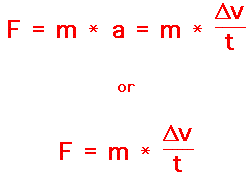Impulse and
Momentum
Momentum
In classical mechanics, an impulse is defined as the integral of a force with respect to time. When a force is applied to a rigid body it changes the momentum of that body. A small force applied for a long time can produce the same momentum change as a large force applied briefly, because it is the product of the force and the time for which it is applied that is important.
The impulse is equal to the change of momentum.

If both sides of the above equation are multiplied by the quantity t, a new equation results.
The quantity(Force X time) is known as impulse.
Impulse I produced from time t1 to t2 is defined to be
where F is the force applied from t1 to t2.
Momentum can be defined as "mass in motion." In terms of an equation, the momentum of an object is equal to the mass of the object times the velocity of the object.
Momentum = mass x velocity
= m x v
where m is the mass and v is the velocity.
And the quantity mXv is called the momentum,If initial velocity of the particle is V1 and final velocity is V2 ,then the quantity mXΔv must be the change in momentum.
change in momentum (mXΔv) = Final momentum - Initial momentum
m( v2-v1) = mv2 - mv1
The equation really says that the
Impulse = Change in momentum
-
 =
=
mv2 - mv1
 = mv2 - mv1
= mv2 - mv1
Momentum Conservation Principle :
If the sum of Impulses due to external forces is zero the momentum of the system remains constant or conserved.
mv2 - mv1 = 0
mv1 = mv2 = mv3 .........mvn = constant
Comments
Post a Comment